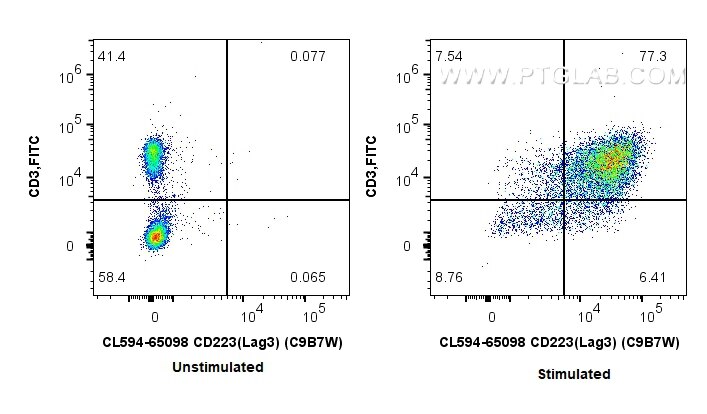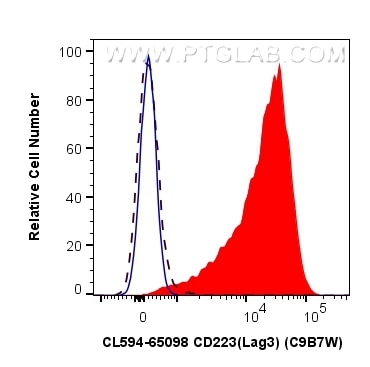Validation Data Gallery
Tested Applications
| Positive FC detected in | anti-CD3/CD28 stimulated mouse splenocytes |
Recommended dilution
| Application | Dilution |
|---|---|
| This reagent has been tested for flow cytometric analysis. It is recommended that this reagent should be titrated in each testing system to obtain optimal results. | |
| Sample-dependent, Check data in validation data gallery. | |
Product Information
CL594-65098 targets LAG-3/CD223 in FC applications and shows reactivity with mouse samples.
| Tested Reactivity | mouse |
| Host / Isotype | Rat / IgG1, kappa |
| Class | Monoclonal |
| Type | Antibody |
| Immunogen | Murine CD223-Ig fusion protein 相同性解析による交差性が予測される生物種 |
| Full Name | lymphocyte-activation gene 3 |
| GenBank accession number | BC120591 |
| Gene Symbol | CD223 |
| Gene ID (NCBI) | 16768 |
| RRID | AB_3084662 |
| Conjugate | CoraLite®594 Fluorescent Dye |
| Excitation/Emission maxima wavelengths | 588 nm / 604 nm |
| Form | Liquid |
| Purification Method | Affinity purification |
| Storage Buffer | PBS with 0.09% sodium azide , pH 7.3 |
| Storage Conditions | Store at 2-8°C. Avoid exposure to light. Stable for one year after shipment. |
Background Information
Lymphocyte activation gene 3 protein (LAG-3), also known as CD223, is a type I transmembrane protein belonging to the immunoglobulin superfamily (PMID: 1692078). It is a CD4-related molecule that binds MHC class II with high affinity (PMID: 1692078; 9159144). LAG-3 is expressed on activated T and NK cells. Besides, natural CD4(+)CD25(+) Tregs express LAG-3 upon activation (PMID: 15485628). LAG-3 negatively regulates T-cell function and homeostasis, and contributes to the suppressor activity of Tregs (PMID: 14644131; 15485628).
Protocols
| Product Specific Protocols | |
|---|---|
| FC protocol for CL594 LAG-3/CD223 antibody CL594-65098 | Download protocol |
| Standard Protocols | |
|---|---|
| Click here to view our Standard Protocols |

